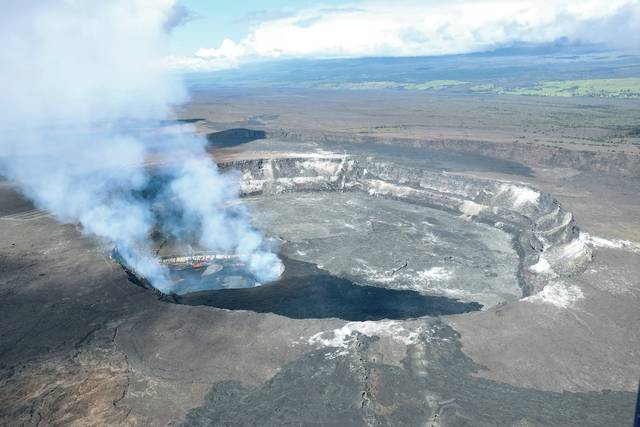We are currently witnessing extraordinary events at the summit of Kilauea Volcano.
For weeks, the summit has subsided in a continuous fashion and in incremental and jolting drops. As Kilauea is being reshaped before our eyes, how does the current activity compare with similar collapses at other volcanoes in the world, or even to previous collapses at Kilauea.
The word “caldera” tends to conjure an image of a huge crater that was the product of a voluminous eruption, like Crater Lake (Oregon) or Yellowstone (Wyoming). Indeed, those are calderas — they formed when large explosions emptied subsurface magma chambers, causing the overlying surface to collapse. But calderas also can form without large explosions.
Calderas are common features on shield volcanoes such as Kilauea and Mauna Loa, and they are not usually associated with large explosive eruptions. Instead, they form when magma drains from beneath the volcano, perhaps to feed some distant intrusion or eruption on the volcano’s outer flank — exactly what is happening at Kilauea’s lower East Rift Zone. There actually have been a few collapse events at volcanoes around the world in the past few decades.
Piton de la Fournaise volcano, on Reunion Island in the Indian Ocean, is similar to Kilauea in many respects — it is a hot spot volcano that erupts frequently from its summit and rift zones. In 2007, a major (for that volcano) flank eruption occurred, and within a week the summit began to subside. During the course of just a few days, an area about 1 km (0.6 mi) across dropped by more than 300 m (almost 1,000 feet). Seismicity indicates that the crater floor dropped in a series of down-dropping events rather than all at once.
Collapse also was observed at Miyakejima volcano in Japan. In 2000, magma left the volcano’s summit reservoir and intruded beneath the submarine flank of the volcano. About two weeks after the intrusion started, the summit crater began to deepen in a series of step-like events accompanied by seismic events (much like what is happening today at Kilauea). During the course of more than a month, a section of the volcano’s crater about 1.6 km (1 mi) across dropped by 450 m (almost 1,500 ft). The collapse was accompanied by a few explosions, some of which dusted areas of the island with ash and produced cold pyroclastic surges.
The 1968 eruption of Fernandina volcano in the Galapagos provides another example of caldera formation. During the course of about a week, the 4-km-x-6.5-km (2.5-mi-x-4-mi) caldera dropped in places by 300 m (almost 1,000 ft). It is thought that a submarine eruption or intrusion must have preceded the collapse. Importantly, and unlike Piton de la Fournaise and Miyakejima, significant explosive activity accompanied the collapse of Fernandina’s caldera, sweeping the summit area and parts of the volcano’s flanks with pyroclastic surges.
Earlier calderas have formed and filled at Kilauea’s summit. We know of at least two such cycles.
One started about 2,200 years ago, before any humans were on the island to observe the activity. After that caldera was subsequently filled with lava flows, a new one formed sometime between the years 1470 and 1510 CE. That caldera-forming event might have made its way into Hawaiian mythology as part of the Pele and Hi‘iaka saga (see this previous Volcano Watch article, https://volcanoes.usgs.gov/observatories/hvo/hvo_volcano_watch.html?vwid=566).
This later collapse “lost” a volume of about 5 cubic kilometers (1.2 cubic miles), about 4 times that of Fernandina’s 1968 collapse and 10 times what we have observed so far at Kilauea. The caldera floor might have been at least 600 m (almost 2,000 ft) deep when the collapse stopped. We know that formation of this caldera was not accompanied by a major explosion, but it was followed by three centuries of repeated explosive activity.
For more information about the current activity and hazards at and around the summit of Kilauea, see this report: Volcanic Hazard at the Summit of Kilauea, June 29, 2018 Update (https://volcanoes.usgs.gov/vsc/file_mngr/file-184/Summit%20scenarios_7-5-18.pdf).
For status updates on volcanic activity, visit the USGS Hawaiian Volcano Observatory webpage at https://volcanoes.usgs.gov/volcanoes/kilauea/status.html.
Subscribe to the Volcano Notification Service to receive emails about volcanic activity at https://volcanoes.usgs.gov/vns2/.
Webcam images: https://volcanoes.usgs.gov/volcanoes/kilauea/multimedia_webcams.html.
View live streaming of summit activity at https://youtube/JlP-8JiKOS8.
Weekly Update (week ending July 7)
On Kilauea Volcano’s lower East Rift Zone, lava from the fissure 8 spatter cone continues to flow in an established channel to the Kapoho coastline. Minor overflows from the channel occur periodically but are short-lived and have not extended beyond the current flow field. At the coast, the northern margin of the flow field is oozing lava at several points in the area of Kapoho Beach Lots. The lava channel has crusted over about 0.8 km (0.5 mi) inland of the ocean entry. Lava enters the ocean over a broad area on the northern side of the entry area. Residents in the lower Puna District of Hawaii Island should remain informed and heed Hawaii County Civil Defense closures, warnings and messages (http://www.hawaiicounty.gov/active-alerts). At Kilauea’s summit, collapse explosions continued to occur during the past week, producing ash-poor steam plumes less than a few hundred meters (1,000 ft) above the ground. The energy released by these events is equivalent to earthquakes of 5.1-5.4 in magnitude. Inward slumping of the rim and walls of Halema‘uma‘u continues in response to ongoing subsidence at the summit.
At Mauna Loa, HVO seismic and deformation monitoring networks have been recording near background levels of seismicity and ground motion for at least the past six months. These observations indicate the volcano is no longer at an elevated level of activity. Accordingly, HVO dropped the Mauna Loa alert level to Normal and the aviation color code to Green. HVO continues to monitor the volcano closely and will report any significant changes.
Volcano Watch (http://hvo.wr.usgs.gov/volcanowatch/) is a weekly article and activity update written by U.S. Geological Survey`s Hawaiian Volcano Observatory scientists and colleagues.


